While St Agnes may have enjoyed an almost unbroken run of interesting birds in October this year — from the appearance of the Blackpoll Warbler on the 6th, to the disappearance of the Blyth's Reed Warbler on the 30th (see here) — I must admit St Mary's held arguably the three most exciting birds of the month, as well as the most controversial. My friends, the resident birders on the Scillies' main island, were never slow to remind me of this on the occasions I strayed from my 'local patch' to go and twitch their birds.
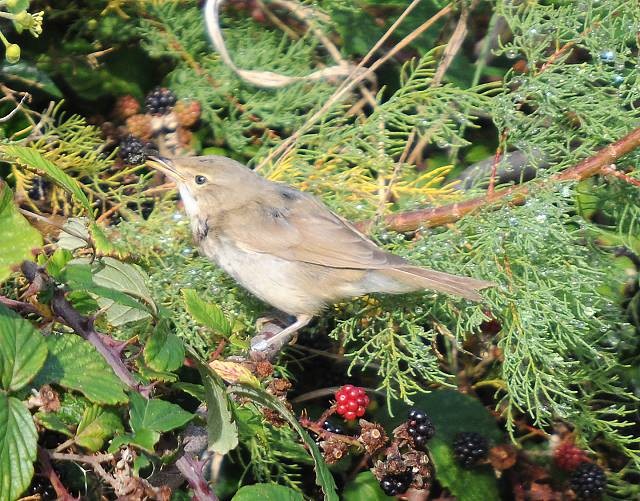
Blyth's Reed Warbler, St. Agnes, Isles of Scilly (Photo: Jim Woods)
St Mary's is where I used to stay for my October fortnights on Scilly in the mid- to late 80s, in the days when everyone who was anyone in the British birding scene used to come here and the place seethed with an excitement and vitality that has, so I was led to believe, dissipated to some degree. It is an island of intense and very visceral memories for me. Throughout this summer on St Agnes I was very aware of her bigger sister across the Sound to the north, and that the potential existed for some deeply pleasurable, nostalgic walks up, down and along Memory Lane. I resisted the temptation to try and do it all at once.
I had occasion only twice in the summertime to visit St Mary's — once to see an MCC representative cricketing side play a Scilly Isles Combined XI on a pleasant August afternoon; and the second time when I got marooned after a summer evening's pelagic trip. On this latter occasion, the following morning gave me an opportunity for my first proper stroll around the island in 17 years and let me tell you, if you don't already know, it is a very, very strange (and quite wonderful) experience to go back and revisit a place after such a long absence. As I've mentioned before here, when talking about my return to Norfolk after a gap of ten or twelve years, one gets the chance to meet what Mark Cocker memorably called 'that strangest of creatures...my Former Self.'
One also gets terribly lost!
I didn't have a map with me on this first morning back on old stamping grounds, relying on instinct and the precarious fallibility of memory. In fact I quite enjoyed drifting in and out of the realms of the familiar and the not-so-familiar, like those extra twenty minutes in bed on a cold winter's morning when one exists in a twilight zone of the dream state and full waking consciousness. For fully thirty minutes heading north out of Rocky Hills I found myself on a completely unfamiliar track, bordered by tall muddy banks and stunted elms, and heading past fields I struggled in vain to remember. Had I been this way before? There was a pleasurable dawning of recognition as I came out at the top end of Holy Vale — my vaguely intended destination for the morning — but then again: coming out at the bottom of Holy Vale twenty minutes later after a brief flirtation with familiarity; which way was it back to town? Where do I end up if I go that way through Higher Moors? How long does this road past Porthellick House take to get there? If only I could remember.
Geography aside, there were the little things that popped up that brought a pleasurable 'aha' of recognition: a bench where I might have once sat in the sun; the bridge where I once stopped and chatted to Peter Grant months before he passed away; the Potter's Studio at the base of the track to the airport; the cottage called 'Nowhere' at the base of the Old Town Church road. All were still there, I see.
My two relatively brief midsummer visits to St Mary's were conducted on days when there was nothing of any real interest birdwise going on. I wondered how soon it would be before I would be tempted back to twitch something special. Not that soon, as it turned out. For some reason I wasn't attracted by the Hudsonian Whimbrel that turned up on St Mary's in mid-September, and Citrine Wagtail and Bonelli's Warbler occurred on days when I was having too much fun (or working) on St Agnes to want to go across and see them. At seven quid a pop for a return journey on the boat, I didn't want to end up getting too twitchy too early in the season in case I was going to have to shell out for the journey ten times during October!
In fact it was the 12th of October before anything really exciting turned up on St Mary's. The trouble was it turned up too late in the day for me to do anything about it — and also, it occurred minutes before I found myself trying to piece together the pieces of the jigsaw puzzle of the Acrocephalus warbler that eventually became the Blyth's Reed Warbler I wrote about last time. A Sociable Plover might have been a much-welcomed 'first' for the Isles of Scilly, but for me, it was complicated by the situation of having to try and re-find the warbler first thing next morning. I saw some of my friends' photos and videos of the Sociable Plover that evening and resolved I'd make the effort next morning. Instead, the following day, very early doors, I found and then promptly lost a Grey-cheeked Thrush that also took the sting out of my desire to want to leave St Agnes and go off twitching. Perhaps tomorrow?
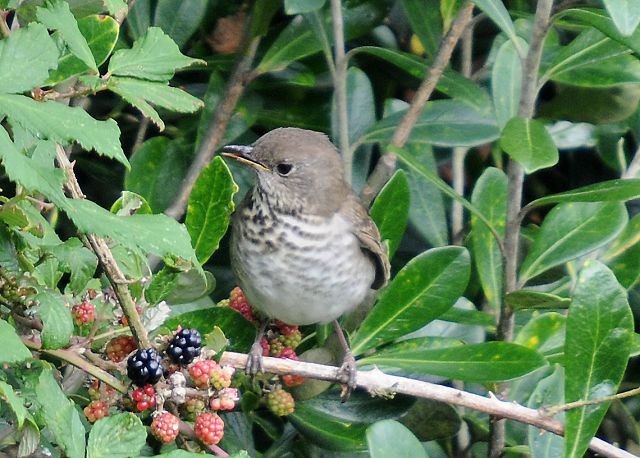
Grey-cheeked Thrush, St. Agnes, Isles of Scilly (Photo: Jim Woods)
I think eventually it was the fourth day before I went across on my own and twitched the Sociable Plover. In the light of what had just taken place on St Agnes, I'm afraid to say, there was something of an anti-climax about the event. I'd seen three Sociable Plovers in the UK, all a long time ago, but because of its status as a Threatened Species and because I'd never seen any others anywhere else in the world, I was really pretty keen to see it. But 'keen' for me these days doesn't mean the same as those manic days of yore. Four days late, last off the boat, I stopped off for a coffee and a 'How are you doing' with Alan Hannington, the secretary of the Isles of Scilly Bird Club, before finally strolling up Telegraph Road to view the bird in fields adjacent to the turn off to Porthloo. The bird was there all right: dead easy, right next to the road; but unfortunately, it wasn't doing anything much at all. My friends' video from the first day had shown it trotting along in typical plover style, cocking its head to one side, and reaching down to snap up morsels from the ground, but here, now, three days later, it was lying down in the field looking somewhat out of sorts with itself. Fears of it going the same way as the famous 2004 Cream-coloured Courser that eventually keeled over and died were hard to suppress. Of course, we know if we chase lost, tired, long-distance migrants there is a chance they are going to die somewhere soon, but we don't want to see it happening before our eyes.
I returned three times during the day to the plover field over the course of several hours, but I left it in the exact same place and pose as I'd first seen it. The St Mary's birders went on to work out that it was feeding at night, and it did, eventually, depart the islands rather strongly to the east. So that was a satisfactory enough ending — even if I didn't get as much out of it as I would have liked; indeed this same underdone theme continued throughout the day's twitching as I went on to get spectacularly bad views of my first Hawfinch since 1990, and an even worse look at my first on-the-deck Jack Snipe since...well, anyway, since even further back than then. I headed back to St Agnes thinking maybe I'd give the off-Agnes twitching a miss after all this October.
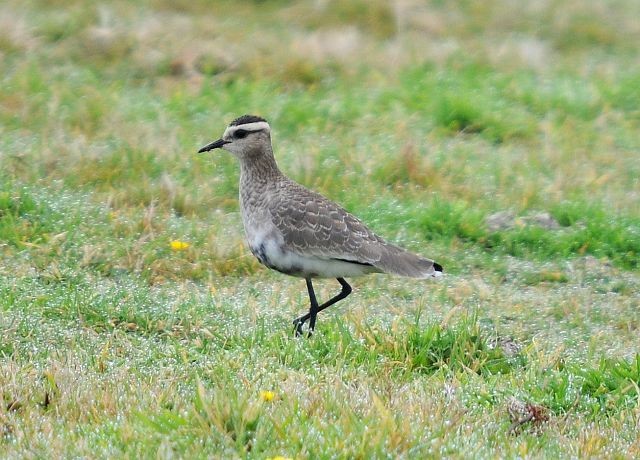
Sociable Lapwing, St. Mary's, Isles of Scilly (Photo: Jim Woods)
That resolution didn't last long! Not when the islands' first-ever Red-flanked Bluetail turned up on St Mary's a couple of days later. I was still riding the crest of a high having found a Bobolink two hours earlier when, at four o'clock in the afternoon, I got the call as I strolled about the Wingletang Downs. I was with my friend Chris Ridgard at the time. This time the twitchometer went off the scale. No matter the fact I've seen fifty or sixty 'Orange-flanked Bush Robins' in various parts of southeast Asia, I can't tell you how much I've been gagging to add to the single bird I saw in the UK in Dorset in 1993. I don't think any of us who started our twitching back in the Eighties (or even earlier) will ever lose the magic of hearing the words "Red-flanked Bluetail" turning up at a nearby location. The fact that available Bluetails have been steadily increasing in Britain over the past ten or so years has been lost on me, as I've been out of the country for most of that time. We started to run. Yes, I ran. Oh, it was glorious! The adrenalin and excitement were pumping, just like old times.
The reason Chris and I had to run was that we were twenty minutes' walk away from the St Agnes quay and our hastily arranged boat had to leave in ten minutes to pick up passengers on the other side. We got there in time. Surprisingly there were only two other St Agnes birders on the boat — the rest, presumably, having connected with one or other of those mainland birds indicated above. Alas, we ended up getting rubbish views of the Bluetail this first evening. The light was fading fast and the 150 birders still present on Scilly as late as 21st October were crammed into a tiny viewing space halfway down Salakee Lane. The hedge the bird had first appeared in was so far away I could barely tell a Robin from a Dunnock. After half an hour's wait, with the first star just about to appear in the blackening sky, a small dark bird flew across a gap in the hedge, flashing its cobalt tail, and that was the last anyone saw of the bird before bedtime. It wasn't there the next day.
Amazingly, a week later, a couple of hours earlier in the day this time, we enacted much the same scenario a second time. "Red-flanked Bluetail, Newford Duck Pond." Again I was with Chris; again we had to organize ourselves a boat - six of us this time; again we had a taxi waiting at the quay on the St Mary's side to take us the two miles to the bird. Again there was no sign of it when we got there!
We were now in the last days of October and cold northeasterly winds swept in across the Scillies, bringing stinging wintry showers, as well as hundreds of Redwings and Chaffinches. It was most uncomfortable hanging around the Pond waiting for the Bluetail to reappear. After an hour and a half I could take no more. I had three-quarters of an hour to get back for the return boat and I set off at a brisk pace, arms swinging wildly to keep warm. I got stuck behind a little old lady with a dog on the narrow track through Holy Vale and after ten minutes of anxiously trying to get past her — she seemed quite oblivious to my presence — I had no option but to say: "I'm sorry, love, would you excuse me..." I made it to Hugh Town with ten minutes to spare...just as news came through that the Red-flanked Bluetail had reappeared! As luck would have it, my old mate John Higginson was in town, driving his work's van, and within thirty seconds of learning of the Bluetail's reappearance, I was whisked off back in the direction I had just come from. Brilliant. Twitching Scilly-style. Surely we couldn't fail this time? Even with (again) barely an hour of light to spare.
This time it was there on arrival. A kindly birder who'd been watching through his scope for fifteen minutes allowed me to save time trying to find the thing myself and I saw it straightaway — a dumpy round Robin-shaped thing sat quietly at the edge of a large cultivated field, orange-red flanks burning through the late afternoon gloom. There were hardly any gaps in the hedge for the hundred-strong crowd to look through but eventually I found myself a spot and set up my own scope for a longer and more satisfactory view. At first the bird flitted in and out of the surrounding hedgerow, occasionally settling low to the ground for ten seconds or more; then, eventually, it came out right in the open, and started perching on some low bean-poles in the middle of the field. It was further away than I would have wished, the light was poor, but nevertheless it was as exciting and as wholesome an event as I could have wished for. Whether this was the same bird I chased eight days earlier (a mile away from the previous site) is a matter of debate; it was gone again next morning. I still haven't fully satisfied my Bluetail craving in this country — perhaps I never will — but it was enough for the time being.
I'd missed my boat back. Not for the first time I was grateful to Alan Hannington and his partner Melanie who put me up in their luxurious guesthouse overlooking the harbour on the Strand at St Mary's. An evening at the bird log in the Scillonian Club followed and I had a brief chat with a bloke called Griff Rhys-Jones who was over with fellow comedians Rory Bremner and Dara O'Briain, filming a show called Three Men in a Boat. I was trying to persuade Rhys-Jones and his producer to come over to St Agnes — "the loveliest of all the Scilly Islands" — but apparently they had plans to go to Tresco filming the next day. Anyhow, I had things to do myself the next morning as I had time for a more leisurely stroll in perfect late autumn sunshine around a few more old haunts on St Mary's. The Bluetail had gone but there was a Grey-cheeked Thrush to 'collect' just outside town, and then I set off on a pilgrimage to the far northeastern corner of the island and one of my Former Self's favourite idyllic little spots in the world: Watermill Cove. I don't know why, I don't remember ever seeing any good birds up there, it was just somewhere that appealed to the Famous Five reader in me back then. This time it was nice to have a look, but if I'm honest it was more just to tick it off on my hypothetical 'list of places to see'. For better or for worse, the place has now been superseded by Covean on St Agnes as my ultimate 'secret little cove'.
The time came for me to get back for my midday boat after what had been a most enjoyable twenty-four hours on the island. I met my mate Chris at the Mermaid — St Mary's "Departure Lounge" he called it — for a swift half before heading for home. We both had work engagements to attend to on St Agnes that had been postponed in the wake of the Bluetail alert. My telephone rang: Alan Hannington — "I've just had a Snowy Owl fly over my head!" says he. I put the phone down after receiving some garbled instructions and turned to Chris with a look of utter disbelief. Whilst not exactly the last bird you'd expect to see on Scilly in October, it was certainly one that was far, far from our minds.
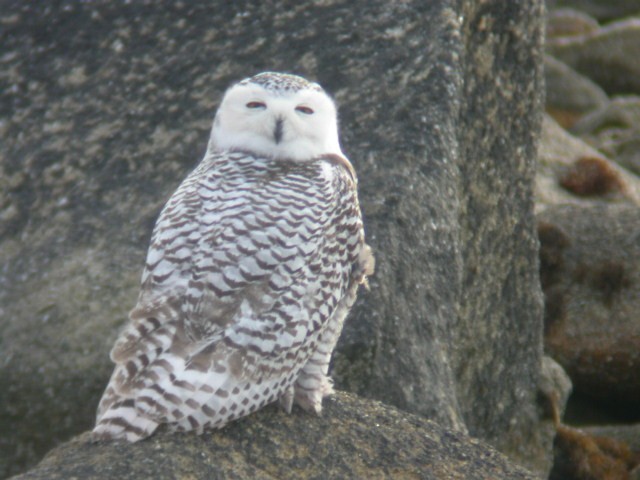
Snowy Owl, St. Martin's, Isles of Scilly (Photo: Mark Worden)
I know I go on too much here sometimes about how many of this I've seen or how many of that I've seen, and I hope you don't read it as a boast, it's just my way of putting a context on things. In world terms, Snowy Owl is still a major biggie for me. I saw two more than twenty years ago on the Shetlands and one (somewhat distantly) a couple of years ago in Ireland. More pertinently, I missed one in excruciating circumstances one day in Cape May — it's too long a story — and the memories of that particular painful dip still rankle ten years later. As more than one Hollywood movie cop has probably said over the years as he closes in on some bad guy who has done him wrong at the start of the film: "This is personal."
Obviously I wasn't the only one who still had 'issues' with Snowy Owl. For several birders I spoke to later it was a new bird; some, like me, hadn't seen one in Britain since the Shetland birds disappeared many years ago. As Chris and I tumbled headfirst out of the pub a couple of birders were running wildly along the main street. A taxi driven by Island birder Chris 'Spider' Webb had already been sent down to meet us, and he found us within a minute. "Get in, quick!" he shouted, and we did. A minute later we spotted a guy wearing bins and carrying a telescope strolling innocently along the Strand. He hadn't heard the news. "Get in, quick!" roared Chris, and after a moment's hesitation in which our kidnap victim managed to formulate the word "Why?" he too duly obeyed. A couple more...well, I wouldn't exactly call them 'stops' occurred along the way and several more birders were bundled into the van. It was breathtaking. I wonder if you are beside yourself with excitement does that mean you have to pay double the taxi fare?
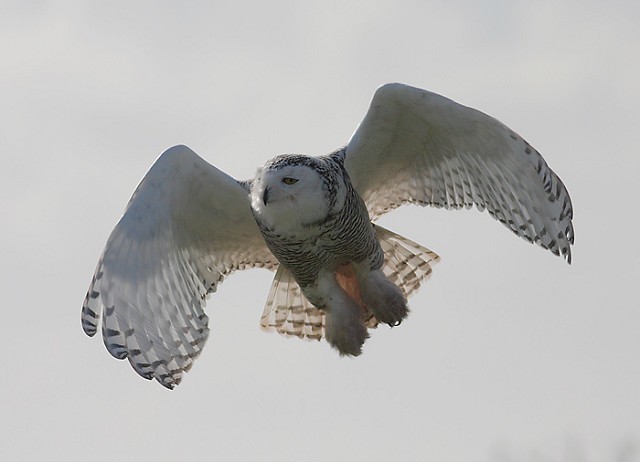
Snowy Owl, St. Martin's, Isles of Scilly (Photo: James Packer)
Once more it was the north end of St Mary's that was seeing the action and it was the main road between Telegraph and Trenoweth we were zooming towards. Unlike the previous couple of scenes I'd seen on St Mary's recently, where, arriving from St Agnes, I was already an hour or two behind events, on this occasion everything was just in the process of unfolding. Birders were jostling for position, tripod legs were being quickly extended, panic was in the air. And sat there...I can barely believe it even now. I wish you could have seen it. This was no ordinary bird. This was not a Blyth's Reed Warbler or some recently split seagull from the eastern Mediterranean; no Blackpoll Warbler or Red-eyed Vireo could ever look this good; hell, I'm not usually into 'raptors' that much myself. Oh God, I'm babbling...
But babbling is about the only reaction one could have to this huge, feathered Russian-doll-shaped creature with the piercing yellow eyes, sat thirty yards from us on a dry-stone wall. Not to be rendered temporarily incoherent at the sight of this Thing sitting so close was not to be human — or at least to be a human who lacked a soul, if such a thing exists. There were grown men practically weeping in the road. Islanders who have little more than a passing interest in the madcap antics of the October birders joined the assembly and expressed their approval at the sight of the Owl. Bird artist Ren Hathaway brought his wife and three children along to the event and they cooed and aahed with obvious delight. "It's Hedwig from Harry Potter!" one of them said, and the other two readily agreed.
Our absorption of the Owl continued for an hour and a half as it moved from this one field close to the road up onto someone's chimneypot (!) briefly, and then back down into another field just behind Telegraph. The frontal system we all knew was coming was edging gradually closer by the minute — and just as it began to rain steadily the Owl upped and flapped off over towards the Golf Course. To my horror, I saw that a minibus of birders from St Agnes had only just arrived the minute the bird had flown off, and now, with most of the crowd starting to disperse back to their cottages and guesthouses as the rain pounded down, they were left desperately to their search. Alas my compassion (and the recognition that this might have been me if I hadn't already been on St Mary's for the Bluetail) didn't extend to help them search for it in this weather. It was by far the worst downpour of the month. Once more, the warm, generous hospitality of Melanie and Alan was gleefully accepted by this very wet and very hungry birder. Another night of celebration in the Scillonian Club duly ensued.
There is one more visit to St Mary's to tell of briefly before I sign off — a visit that took place between the two Bluetail dates. "October on the Scillies wouldn't be complete without its annual controversy," wrote Richard Millington 28 years ago in his Twitcher's Diary (a Spectacled/Subalpine Warbler that was eventually trapped and established as the latter); and 2008 continued the tradition. On Sunday 26th October a call came through to St Agnes in the evening to tell me of a potential Brown Shrike at the northeast corner of St Mary's — a 'possible' that had been upgraded to a 'probable' by the time I went to bed. Confirmation that the bird was still there next morning ushered a dozen of us across on the scheduled 10:15 boat; and once again, a taxi was waiting on the other side to whisk us to the top right-hand corner of the island. I did hear that there were still some who were questioning the identity of the bird as a Brown Shrike — favouring Red-backed instead — but by the time we got there, it seemed a consensus had been reached: there were a hundred happy-looking birders staring at it in a hawthorn hedge. For my part, my first view of the bird was a dorsal view and from behind it fitted memories of the Brown Shrikes I'd seen fifteen years ago in southeast Asia: the right colour tone to the upperparts; unusually long tail; nice stubby bill. What was the problem?

Putative Brown Shrike, St. Mary's, Isles of Scilly (Photo: Joe Ray)
The problem, apparently, was that, for those in possession of a Dutch Birding identification paper from six years ago, there were several things wrong. The base of the bill wasn't pale enough, the upperparts were too chestnut, a Brown Shrike was supposed to have moulted completely into first-winter plumage by this time of the year, and not be retaining as many juvenile feathers as this bird did. Most crucially, a Brown Shrike was only supposed to show four or five primaries projecting beyond the tertials, not the six or seven of Red-backed Shrike. By the end of the day, the pro-Red-backed camp had gained the upper hand and the Brown Shrike was removed from the birding services' reports and supposedly 're-identified' as the commoner species. My own opinion is that the answer to the problem may lie somewhere in between these views. I conducted some research on the Internet and found several authors in faraway places (for example South Korea, where Brown Shrike is very common) expressing the opinion that the characters of certain shrikes seem to overlap so consistently that 'specific identification of individual extralimital shrikes may not always be possible.' Indeed, research conducted by Lars Svensson (among others) in Kazhakstan — where the ranges of Brown, Turkestan (Isabelline) and Red-backed Shrikes come into contact — suggested that the lines we draw between these three 'species' may not be as neat and as clear-cut as we like to think and that hybrids have proved not infrequent in occurrence. Personally, I very much dislike the 'hybrid theory' in most cases when it comes to vagrants in Britain — I know of several cases where birders, having made a mistake, have tried to 'hide' behind the hybrid theory — but in this instance it seems the obvious solution. It was Keith Vinnicombe who first identified the bird as a Brown Shrike, and I know Keith as one of the most rigorous and intelligent (and one of the most approachable and nicest) of all British birders. I chatted to him in the pub about the bird afterwards. He's not going to make a mistake if the bird was a straightforward Red-backed Shrike. Whatever the photographs published since the event seem to show (and I admit that most of the ones I've seen — though not all — make it look more like a Red-backed than it appeared in the field), the memory of the first sight of that tail, and the brown cast to the upperparts, and the almost square-shaped, stubby bill, will not go away. I doubt whether the bird will now be accepted as a Brown Shrike, though I strongly suspect that at least one of its parents was of that form. I actually have a photograph taken this year in China of an obvious adult male Brown Shrike with six primaries projecting clearly beyond the tertials, so I ask myself is that feature really valid as a pointer to one 'species' or another? One of the most interesting aspects of the case for me is that I got back after seeing the bird and found a picture of the 2001 Brown Shrike on Bryher and — primary projection apart — they look like the same bird! I notice that Keith has published shots of the 2008 bird on the Web alongside the 2001 bird and he seems to be suggesting the same thing too.

Putative Brown Shrike, St. Mary's, Isles of Scilly (Photo: James Packer)
Maybe there will be more to be added to the knowledge of shrike identification after this event, but for now, let us be grateful for Snowy Owls and Red-flanked Bluetails. They, and to a lesser extent the Sociable Plover, provided me with some deliciously exciting moments this October, and perfect excuses for re-visiting an island where so many intense, magical moments happened to me in the 80s. At the time of writing (rather late, I know, but what can you do), I'm sitting here preparing for another exciting twitch to St Mary's first thing tomorrow morning. As you probably already know, there's been a white Gyrfalcon knocking around the Golf Course, and after an anxious couple of days I've finally managed to manipulate a day off in order to go look for it.
Wish me luck.

